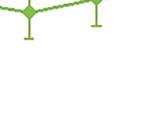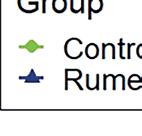RUMEN-READY®: PREPARTUM MAGNESIUM BUTYRATE SUPPLEMENTATION FOR A SMOOTHER TRANSITION AND BETTER PERFORMANCE OF DAIRY COWS
Dr Joan Edwards, R&D Expert (Ruminants), Palital Feed Additives B.V., NetherlandsRumen-Ready® is magnesium butyrate formulated for release in the rumen of transition dairy cows during the dry period. It is well established that butyric acid promotes gut development in young calves, but why feed butyric acid to a mature ruminant? In this article, the answer to this is given along with the science behind Rumen-Ready® and its unique benefits for transition cows.
Transition is characterized by change and challenge
Transition cows are on a roller coaster ride, experiencing a lot of change within a few weeks before and after calving (Figure 1). Therefore, it is perhaps not surprising that transition is a very high-risk period for feeding and management-related diseases. For example too slow an increase in ration nutrient density and intake after calving can leave the cow with limited energy & nutrients. This leads to higher ketosis and hypocalcemia risk as well as lower milk production. Conversely, aggressively increasing concentrates to reduce this risk can result in accumulation of volatile fatty acids (VFA) in the rumen, and a higher risk of subacute ruminal acidosis (SARA). Feeding transitions cows is a balancing act that can, and often does, go wrong.
Figure 1: Changes in the main physiological aspects of healthy cows during the transition period. Ideally, the Negative energy balance (NEB), inflammation, and oxidative stress would be close to zero (i.e. absence of the phenomena), whereas the immunocompetence and calcium levels would be close to 100% of their optimum capacity.

VFA drive rumen redevelopment
During the dry period, the diet of dairy cows is low in easily fermentable carbohydrates, which decreases the ruminal production of VFA. As a consequence, the size of rumen papillae can decrease during the dry period by more than 50%. This increases again following the switch to the lactation diet after calving, however, this increase is slow. Maximum rumen papillae redevelopment is only observed 50–60 days after calving. As the extent of VFA absorption is influenced by the available rumen wall surface area, the effective absorption of VFA correlates with the number and size of papillae. This means that during early lactation there is a substantial delay in ruminal absorption of VFA, as well as other nutrients. This has negative consequences for the animal in terms of health and performance. For example more limited VFA and nutrient uptake can make the cow’s negative energy balance worse, increasing the risk of ketosis developing during this vulnerable time.
Butyrate is the most potent VFA
Butyrate is one of the VFA that is naturally produced in the rumen, but its production is minor compared to acetate and propionate. Feeding butyrate to dairy cows during the dry period has been shown to increase rumen papillae length and thickness, resulting in a greater rumen wall surface area. Whilst acetate and propionate can also stimulate rumen wall redevelopment, butyrate is more effective. This is because in addition to stimulating epithelial cell proliferation, butyrate also specifically inhibits cell death. As well as this, butyrate increases the amount of VFA transport proteins in the rumen wall tissue, which facilitates increased VFA uptake. Most of the absorbed VFA are removed from the rumen tissue into the blood, and butyrate also works by increasing ruminal tissue blood flow. Combined this means that feeding butyrate prior to calving will result in earlier rumen redevelopment. This means that the rumen, and cow, are better prepared for lactation.
Which form of butyrate is best for transition cows?
A limited amount of easily fermentable carbohydrates are fed to dry cows in the last few weeks prior to calving. However, only a small amount of the VFA produced from its fermentation will be in the form of butyrate. Furthermore, feeding the cow with an excess of nutrients prepartum is known to increase the development of issues such as fatty liver, and more recently research has indicated that it can also compromise colostrum quality. Due to this, it is a lot more beneficial to directly supplement butyrate in the prepartum diet. To date, butyrate has only been commercially available for ruminants in the form of calcium and/or sodium butyrate salts. Whilst in general both are good sources of butyric acid for ruminants, neither should be supplemented prepartum at the functional level required for rumen redevelopment. Dietary supply of calcium in the weeks prior to calving needs to be minimized in order to enable optimal calcium mobilization of body reserves during early lactation. Sodium is also an issue due to its effect on dietary cation anion difference (DCAD), which is a common strategy to prevent hypocalcemia in dairy cows. As such, an alternative butyrate salt has been specifically developed by Palital for use in transition cows: magnesium butyrate. This is the key active ingredient of Rumen-Ready®.
Bioavailable magnesium
Magnesium (Mg) is an essential nutrient for cows. This means that dairy rations need to supply a sufficient amount of absorbable Mg to safeguard the cow’s health. Too little Mg results in hypomagnesemia (also known as grass staggers or tetany), and can also result in secondary hypocalcemia (milk fever). This is because magnesium stimulates the parathyroid hormone, enabling more effective calcium mobilization when it is needed. As such, a good Mg supply is particularly important prepartum due to the rapid change in calcium requirements around calving (Figure 1). The amount of Mg that is available for metabolism depends on the intake level,
Mg source and most critically the efficiency of Mg absorption. Mg absorption is never 100% due the negative impact of dietary potassium (K) on this process. As such, when diets have a high K content the cows are at a higher risk of developing a Mg deficiency. Unlike magnesium oxide, 100% of the magnesium from Rumen-Ready® is soluble in the rumen, which is the main site of Mg uptake in ruminants. Furthermore, Mg absorption in the rumen is also stimulated by butyrate. Academic research by Palital has shown that the Mg uptake into the blood (i.e., its bioavailability) from Rumen-Ready® was 72%. This is three times higher than even a highly pure MgO with good rumen solubility (or 10X higher than a feed grade MgO with very poor rumen solubility).
Colostrum boost
The end of the dry period not only marks the start of lactation, but also the birth of the calf. Butyric acid is known in monogastric mammals to improve colostrum quality. Palital has been the first to document this effect also occurs when butyrate, in the form of Rumen-Ready®, is fed to cows prepartum. Palital’s own academic research clearly shows that Rumen-Ready® increases colostrum quantity without decreasing quality (Table 1), which results in an increased yield of all the colostrum components. In field trials the IgG content of the colostrum is often enhanced when colostrum quality on farm is poor (i.e., <50 g IgG/L), unlike in the farm where the academic study was conducted (Table 1). The productivity of replacement heifers is known to be increased when optimal colostrum management is used (i.e., the 3 Q’s: quantity, quality and quick). Colostrum is key though not only for the nutrition and health of newborn calves, as research shows that its prolonged feeding (even after gut closure to IgG uptake) can also boost calf health and intestinal development. Furthermore, with the recent move to vaccinating cows prepartum against common causative agents of neonatal calf disease, the importance of optimal colostrum management to deliver specific antibodies to the newborn calf is more important than ever.
Improved lactation performance













































































































After feeding Rumen-Ready® for just three weeks before calving, it is not just colostrum that is improved but also milk performance. Academic research by Palital has shown that prepartum supplementation of Rumen-Ready® significantly improves milk yield as well as milk composition over the first 70 days in milk (DIM): increasing milk fat and protein content and decreasing somatic cell count (Figure 2). Relative to the control group in the trial, dry matter intake postpartum did not change and body condition score was improved. Together, these trial findings indicate that Rumen-Ready® supplemented cows produce more milk with an improved feed efficiency. As well as performing academic trials, Rumen-Ready® has been assessed in numerous field trials under different conditions. In the Netherlands, Rumen-Ready® improved milk production by 0.9 kg/cow/day during the first 60 DIM. Another field trial in Spain showed milk yield increased by 2.6 kg/cow/day during the first 38 DIM, and over the first 112 DIM the milk yield averaged out as 1.0 kg/cow/day. Under heat stress conditions in a field trial in Egypt, Rumen-Ready® resulted in 3.5 kg/cow/day more milk during the first 62 DIM.



































Better transition cow health
Healthy cows are more productive, and this is also the case with Rumen-Ready® supplemented cows. Transition related diseases are decreased in cows fed Rumen-Ready® during the close-up period, for example lower incidences of retained placenta, SARA, ketosis, mastitis have been observed in numerous different trials that have been conducted to date. Underlying this appears to be a lower level of systemic inflammation during lactation, which has been documented using haptoglobin as a biomarker in an academic trial. It is perhaps not surprising that these healthier, more productive cows also have improved fertility. Prepartum feeding of RumenReady® has been found to decrease the number of days to first heat and number of services per conception, as well as decreasing embryonic and early fetal mortality incidence.
Prepartum supplementation of Rumen-Ready® for only three weeks until calving (i.e. 21 days) has a very broad range of benefits for cow performance and health, and also benefits that extend to the calf. Decreased incidence of cows needing assistance during calving has been observed in Rumen-Ready®supplemented cows, and a significantly less stressful birthing process for the cow and calf. For the calf, this translates to a higher vitality score at birth. Also, when calves received a set volume of colostrum from their own dams, calves from Rumen-Ready® supplemented cows were found to have a much lower incidence of diarrhea (-41%) and respiratory disease (-57%).
Giving the cow and calf the best start
Rumen-Ready® is a complementary feed that delivers butyric acid and magnesium in a matrix encapsulated form. Encapsulation ensures optimal release of both components inside the rumen, as well as problem free handling of the product along the supply chain whether mixed directly into the ration on farm or pelleted into a concentrate feed. Prepartum feeding of Rumen-Ready® for just three weeks until calving gives a broad range of benefits resulting in increased performance as well as decreased losses. In conclusion, Rumen-Ready® is an innovative concept to improve the performance and health of transition cows, whilst also benefitting the calf. Are you ready to find out more? Please just visit www.palital.com or contact Joan Edwards directly (j.edwards@palital.com).
Further reading:
• Kovács, L., Pajor, F., Bakony, M., Fébel, H. and Edwards, J.E. (2023) Prepartum Magnesium Butyrate Supplementation of Dairy Cows Improves Colostrum Yield, Calving Ease, Fertility, Early Lactation Performance and Neonatal Vitality. Animals, 13(8), p.1319.
• Fébel, H., Edwards, J., Pajor, F., Jurkovich, V., Bakony, M. and Kovács, L. (2023) Effect of Prepartum Magnesium Butyrate Supplementation on Rumination Time, Milk Yield and Composition, and Blood Parameters in Dairy Cows. Veterinary Sciences, 10(4), p.276.
• de Groot, B.M., Edwards, J.E., Schonewille, J.T. (2023) Magnesium butyrate is a readily available magnesium source in dairy cow nutrition. Animal Feed Science and Technology, https://doi.org/10.1016/j.anifeedsci.2023.115697
